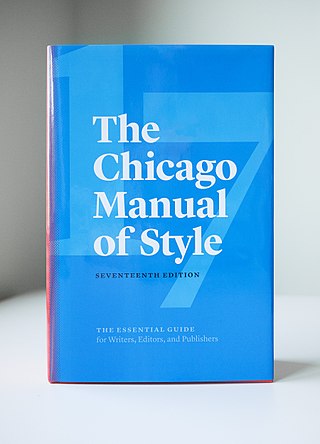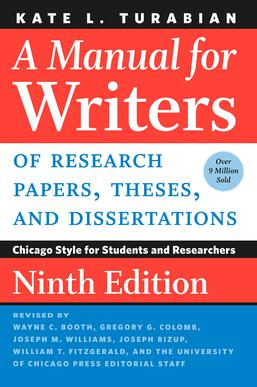
The Chicago Manual of Style is a style guide for American English published since 1906 by the University of Chicago Press. Its 17 editions have prescribed writing and citation styles widely used in publishing.

A citation is a reference to a source. More precisely, a citation is an abbreviated alphanumeric expression embedded in the body of an intellectual work that denotes an entry in the bibliographic references section of the work for the purpose of acknowledging the relevance of the works of others to the topic of discussion at the spot where the citation appears.

Bibliography, as a discipline, is traditionally the academic study of books as physical, cultural objects; in this sense, it is also known as bibliology. English author and bibliographer John Carter describes bibliography as a word having two senses: one, a list of books for further study or of works consulted by an author ; the other one, applicable for collectors, is "the study of books as physical objects" and "the systematic description of books as objects".
A note is a string of text placed at the bottom of a page in a book or document or at the end of a chapter, volume, or the whole text. The note can provide an author's comments on the main text or citations of a reference work in support of the text.

APA style is a writing style and format for academic documents such as scholarly journal articles and books. It is commonly used for citing sources within the field of behavioral and social sciences, including sociology, education, nursing, criminal justice, and anthropology, as well as psychology. It is described in the style guide of the American Psychological Association (APA), which is titled the Publication Manual of the American Psychological Association. The guidelines were developed to aid reading comprehension in the social and behavioral sciences, for clarity of communication, and for "word choice that best reduces bias in language". APA style is widely used, either entirely or with modifications, by hundreds of other scientific journals, in many textbooks, and in academia. The current edition is its seventh revision.
An English writing style is a combination of features in an English language composition that has become characteristic of a particular writer, a genre, a particular organization, or a profession more broadly.
Reference management software, citation management software, or bibliographic management software is software that stores a database of bibliographic records and produces bibliographic citations (references) for those records, needed in scholarly research. Once a record has been stored, it can be used time and again in generating bibliographies, such as lists of references in scholarly books and articles. Modern reference management applications can usually be integrated with word processors so that a reference list in one of the many different bibliographic formats required by publishers and scholarly journals is produced automatically as an article is written, reducing the risk that a cited source is not included in the reference list. They will also have a facility for importing bibliographic records from bibliographic databases.

The American Sociological Association (ASA) is a non-profit organization dedicated to advancing the discipline and profession of sociology. Founded in December 1905 as the American Sociological Society at Johns Hopkins University by a group of fifty people, the first president of the association would be Lester Frank Ward. Today, most of its members work in academia, while around 20 percent of them work in government, business, or non-profit organizations.
An outline, also called a hierarchical outline, is a list arranged to show hierarchical relationships and is a type of tree structure. An outline is used to present the main points or topics (terms) of a given subject. Each item in an outline may be divided into additional sub-items. If an organizational level in an outline is to be sub-divided, it shall have at least two subcategories, although one subcategory is acceptable on the third and fourth levels, as advised by major style manuals in current use. An outline may be used as a drafting tool of a document, or as a summary of the content of a document or of the knowledge in an entire field. It is not to be confused with the general context of the term "outline", which a summary or overview of a subject, presented verbally or written in prose. The outlines described in this article are lists, and come in several varieties.
A citation from the Bible is usually referenced with the book name, chapter number and verse number. Sometimes, the name of the Bible translation is also included. There are several formats for doing so.
Parenthetical referencing is a citation system in which in-text citations are made using parentheses. They are usually accompanied by a full, alphabetized list of citations in an end section, usually titled "references", "reference list", "works cited", or "end-text citations". Parenthetical referencing can be used in lieu of footnote citations.
An annotated bibliography is a bibliography that gives a summary of each of the entries. The purpose of annotations is to provide the reader with a summary and an evaluation of each source. Each summary should be a concise exposition of the source's central idea(s) and give the reader a general idea of the source's content.

MLA Handbook, formerly MLA Handbook for Writers of Research Papers (1977–2009), establishes a system for documenting sources in scholarly writing. It is published by the Modern Language Association, which is based in the United States. According to the organization, their MLA style "has been widely adopted for classroom instruction and used worldwide by scholars, journal publishers, and academic and commercial presses".
The Vancouver system, also known as Vancouver reference style or the author–number system, is a citation style that uses numbers within the text that refer to numbered entries in the reference list. It is popular in the physical sciences and is one of two referencing systems normally used in medicine, the other being the author–date, or "Harvard", system. Vancouver style is used by MEDLINE and PubMed.
The Institute of Electrical and Electronics Engineers (IEEE) style is a widely accepted format for writing research papers, commonly used in technical fields, particularly in computer science. IEEE style is based on the Chicago Style. In IEEE style, citations are numbered, but citation numbers are included in the text in square brackets rather than as superscripts. All bibliographical information is exclusively included in the list of references at the end of the document, next to the respective citation number.
A style guide is a set of standards for the writing, formatting, and design of documents. A book-length style guide is often called a style manual or a manual of style. A short style guide, typically ranging from several to several dozen pages, is often called a style sheet. The standards documented in a style guide are applicable either for general use, or prescribed use for an individual publication, particular organization, or specific field.

A Manual for Writers of Research Papers, Theses, and Dissertations is a style guide for writing and formatting research papers, theses, and dissertations and is published by the University of Chicago Press.
Sentence spacing guidance is provided in many language and style guides. The majority of style guides that use a Latin-derived alphabet as a language base now prescribe or recommend the use of a single space after the concluding punctuation of a sentence.

AMA Manual of Style: A Guide for Authors and Editors is the style guide of the American Medical Association. It is written by the editors of JAMA and the JAMA Network journals and is most recently published by Oxford University Press. It specifies the writing, editing, and citation styles for use in the journals published by the American Medical Association.







